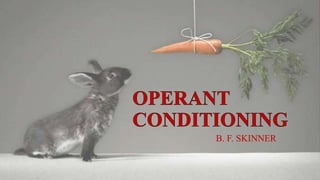
B.F. SKINNER'S OPERANT CONDITIONING EXPERIMENTS
- 2. INTRODUCTION: • B.F Skinner is regarded as the father of Operant Conditioning. • Skinner studied operant conditioning by conducting experiments using animals which he placed in a 'Skinner Box' . • Skinner introduced a new term into the Law of Effect - Reinforcement. 2
- 3. DEFINITION: Operant conditioning is a learning method that takes place through rewards and penalties for behavior. 3
- 4. EXPERIMENT # 1 • Placed hungry rat in the skinner box. • The rat was inactive in the beginning, but he adapt the environment of the box. • Found the lever and by pressing it , food released. POSITIVE REINFORCEMENT
- 6. EXPERIMENT # 2 Instead of food released by the lever, electric current was released when rat press the lever NEGATIVE REINFORCEMENT
- 8. Reinforcement and Punishment • Reinforcement • Reinforcement that closely follows a behavior will encourage and strengthen that behavior. • Types of Reinforcement • Positive reinforcement occurs when a behavior results in a favorable outcome e.g. a dog receiving a treat after obeying a command • Negative reinforcement occurs when a behavior results in the removal of an unfavorable experience e.g. an experimenter ceasing to give the monkey electric shocks when the it presses a certain lever
- 9. Reinforcement and Punishment • Skinner also identified things which can act as reinforcments • Primary reinforcers: naturally reinforce behavior because they are innately desirable, e.g. food. • Conditioned reinforcers: not innately desirable, but we learn to associate them with primary reinforcers, e.g. Paper money, which can be used to acquire innately desirable goods, such as food and shelter.
- 10. Reinforcement and Punishment • Punishment • Punishment which closely follows a behavior discourages and weakens that behavior. • Types of punishment • Positive punishment (punishment by application) occurs when a behavior is followed by an unfavorable outcome e.g. a parent spanking a child after the child uses a curse word. • Negative punishment (punishment by removal) occurs when a behavior leads to the removal of something favorable e.g. a parent who denies a child their weekly allowance because the child has misbehaved.
- 11. Contd.. • Disadvantage of Punishment • not always effective. • Temporarily suppress the undesirable behavior. • also have unwanted side effects. e.g. a child punished by a teacher may become uncertain and fearful because they don’t know exactly what to do to avoid future punishments. Reinforcement tells an individual what behavior is desired, while punishment only tells the individual what behavior isn’t desired.
- 13. SCHEDULES OF REINFORCEMENT: 1. Intermittent reinforcement schedule 13 2. Continuous reinforcement schedule Every desired response is reinforced every single time it is performed. Any rule specifying a procedure for occasionally reinforcing a behavior.
- 14. RATIOS AND INTERVALS OF REINFORCEMENT: There are four basic types of intermittent schedules of reinforcement and these are: • Fixed-Ratio Schedule (FR) • Fixed-Interval Schedule (FI) • Variable-Ratio Schedule (VR) • Variable-Interval Schedule (VI) 14
- 15. 15
- 17. BY: A. Robert Sherman (1973) EXPERIMENT 1 RECENT EXPERIMETS:
- 18. HYPOTHESIS: A person’s behavior will increase if followed by rewards and decrease if followed by punishments. Conducted in naturalistic environment i.e. classroom. Students behavior was observed , in which disruptive students were observed Two objectives of this study are: To prevent the students from disrupting the class by getting out answers and To get the students to lift their hands to address questions. Sherman measured the behaviors emitted by the children after manipulating the different levels of rewards and punishments
- 19. The results showed that students rewarded with praise for acting desirable continued that behavior frequently and engaged less frequently in the undesirable behaviors. In this case students desired attention, the teacher only gave that to them after they showed respectful, obedient behaviors. The teacher made receiving the reinforce (praise) contingent on showing respectful, obedient behaviors. Study demonstrates effective behavior modification This is a perfect example of modifying human behavior because the teacher was able to control the students’ behaviors by virtually eliminating the disruptive behaviors.
- 20. By Philip A. Saigh (1980) EXPERIMENT 2
- 21. Conducted on a group of Lebanese children in Beirut, Lebanon Teacher had a hard time controlling students. She needed to take out two behaviors: talking out of turn and leaving one’s seat without permission The teacher had originally experimented with negative reinforcement with no achievement. Discovered that students enjoy swimming Saigh build up a strategy of modifying behaviors by combining swimming with good behavior Introduced positive reinforcement by placing check for swimming on the board for every ten minutes the students were well behaved
- 22. The results showed that before the positive reinforcement method was used, the students displayed on average 18 disruptive behaviors. On the first day of implementing the check system, behaviors dropped down to 4 incidents The teacher was consistent with reinforcing the students by giving them a check every ten minutes if they deserved one and they could swim for 10 minutes This system was an easy and powerful method of teaching the students to learn respectful behaviors
- 23. 23 Thank You, May Allah give you your reward too.